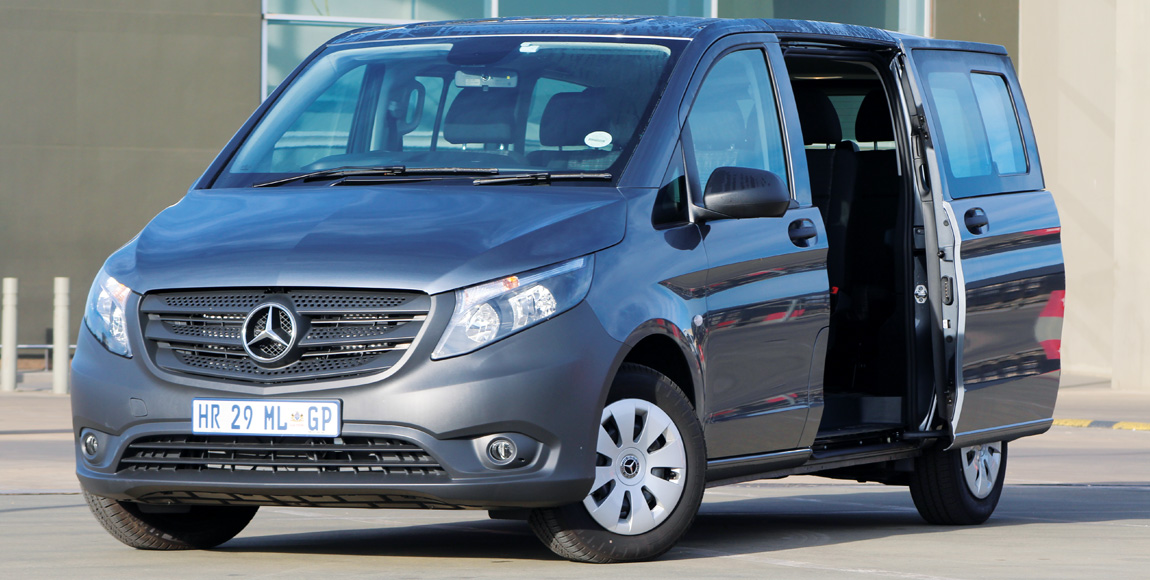Room for one more

Mercedes-Benz has upgraded its Vito 111 Tourer Pro. GAVIN MYERS drove it
Three and a half years after its launch and this is the third Mercedes-Benz Vito of the current generation that FOCUS has had on test. It’s also the most impressive. That’s not because it’s a top-spec model fitted with all the bells and whistles – in fact, it’s the entry-level model in the people-carrying Tourer range.
This Vito impressed because it did something that no Vito I’ve driven since that launch in 2015 has been able to: it didn’t squeak and rattle. There was not a peep from behind the dash, the sliding doors, the seats … niks. Top marks to Mercedes-Benz for improving the Vito’s build quality.
This 111 Tourer Pro is positioned as an affordable all-purpose vehicle; intended to be put to work shuttling people around, or carrying the odd load. As such, it’s fitted with black plastic bumpers; commercial tyres (205/65 R16 C); durable seat upholstery; an easy-to-clean rubberised floor covering; and – to maximise revenue, says Mercedes-Benz – it now comes with an additional, middle seat in the first row.
Mercedes-Benz has also added sliding windows to the side sliding doors; improving comfort levels for passengers in the second and third rows, who continue to enjoy acres of room, comfy seating and easy entry and egress. In fact, the only passenger that will probably not be too comfy is the one that sits in the new front-row centre seat.
Unfortunately, because the front passenger bench is fixed in place (you can’t even recline the backrest) its proximity to the dash-mounted gear lever means this passenger will need to twist or bend his or her body slightly.
What about the driver? This individual seat provides a range of adjustment and is comfortable, provided it’s not set too far back, in which case the fixed passenger bench could hamper movement of the driver’s left arm. As it always has, the Vito rides particularly softly, though road noise does come through those commercial tyres.
Under the bonnet sits a 1,6-litre turbodiesel engine that produces 84 kW and 270 Nm torque from an early
1 500 r/min. It is smooth running, but the notchy six-speed manual box will require quite a bit of stirring with a full load. The Vito 111 averaged a fair 10,3 l/100 km during our week with it.
As with most vehicles of this type, rearward visibility is hindered by the rows of headrests in the driver’s rear-view mirror. Thankfully, the wide side mirrors aid visibility, and the Vito isn’t much of chore to manoeuvre.
Standard equipment includes Crosswind Assist, Attention Assist, Electronic Stability Program, and an anti-theft package.
The Vito 111 Tourer Pro has one particular trump card that its rivals from Volkswagen and Ford do not – that additional seat. These eight-seater models are also more expensive than the Vito. Looking to the Hyundai H1, it, too, has nine seats, but the only model that is priced at the Vito’s level is the 2,4-litre petrol derivative.
At R525 000 with a five-year/120 000-km service plan, the Vito 111 Tourer Pro nine-seater targets a significant niche of the market. For those that need the additional passenger capacity, it’s a solid option – not least because it now doesn’t squeak and rattle…
Published by
Focus on Transport
focusmagsa




